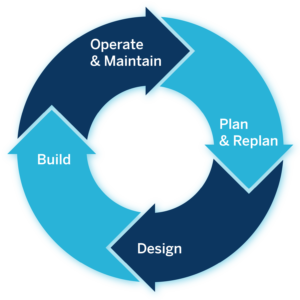The way people, employees, and organizations utilize real estate is constantly changing. As business expectations evolve, adapting employee services and readjusting workspace expectations has to evolve as well.
This poses two problems for real estate leaders:
- How do I set my real estate strategy
- How do I interpret business needs to real estate needs
The impact of business change on real estate strategy can be profound; this has never been more apparent than with the COVID-19 pandemic, which overnight caused fundamental changes in how employees work and, crucially, where they work.
Change is constant, and while most change is far more gradual, real estate leaders must continue to understand how their business is evolving and adapt to changing needs. Being able to react quickly to new technology and customer demands can be crucial to an organization’s competitiveness.
There are many examples of this that we see in our everyday life, including:
- Retail – where convenience stores are increasingly introducing self-check-out kiosks. My personal experience of these services is mixed. In some stores, they clearly speed up the checkout process; in others, the store design is not suitable for the technology – leading to a poor in-store experience.
- Transport – where evolving ticketing and security measures have changed the flow of passengers through the building. Electronic boarding passes speed up entry in some airports, then cause suffering from overwhelmed security, while other airports seem to have adapted well.
- Healthcare – as new treatments become available different equipment may be required. Some facilities can easily manage with the new equipment while others are inflexible and may not be able to offer the service.
All of these examples, and there are many more, highlight the need for real estate leaders to have a clear understanding of the upcoming demands of their business and how their real estate portfolio can adapt to these changing demands across the real estate lifecycle. To do this effectively, these leaders must have access to the data necessary to make evidence-based decisions throughout the four key stages of the building lifecycle, as illustrated below.

To support this process, Nuvolo is specifically designed and built on a single database to ensure all property data is consolidated, providing our clients with a Single Source of Truth.
Planning
Nuvolo brings together key data for lease, space, maintenance, and projects allowing organizations to easily visualize the overall picture of their real estate portfolio using executive dashboards.
This data informs the organization’s strategic plans allowing accurate decisions to be made, backed up by evidence and data. These decisions could include:
- Expansion / Contraction – based on Lease Rental Values and Potential Revenue
- Expansion / Contraction – based on Occupancy Rates
- Refurbishment vs. Relocation
- Repair vs. Replace
- Lease Renewals vs. Break Options
As these and other data points are evaluated, Nuvolo customers can set a real estate strategy that remains dynamic as the data evolves with real-world activity.
In 2020, for example, Nuvolo clients were able to quickly evaluate existing lease options for closed offices and reduce their space costs. This, coupled with space management features, allows for long-term evaluation of the supply of property & space vs. the demand the business has for space.
Design
With detailed space planning tools, organizations can gather information about space utilization for review and needs analysis during the planning process.
Add Maintenance data to provide an understanding of the most cost-effective assets to incorporate within a building (and those not to). This information informs the design process for construction & refurbishment projects.
Businesses realize a higher quality outcome when design and operations teams collaborate. For example, retail stores design a better customer experience with a smoother journey through the store and better brand interactions. Or corporations create a more suitable office design that delivers workspaces aligned to team activities and roles.
Build
Nuvolo supports the planning process by delivering detailed analytics and executing the planned designs via the Projects solution, which can be used to manage all major & minor capital works projects. For example, these could be office refurbishments, store branding, new builds, repair programs, etc.
On completion of these projects, the BIM & CAD drawings are used in Nuvolo Facilitates for ongoing management and visualization of the as-built plans.
Having the data on one platform supports the handover to building operations and informs the facilities teams as to when the site will be available for occupancy allowing for proactive planning for the work that may be required to support building occupation.
Operate
Once a site is operational, Nuvolo Space begins monitoring and measuring occupancy. The solution reports on space allocations, utilization, and stack plans, which informs occupancy levels for bookable spaces, plus allows for a robust reservation application.
Moreover, via integration with sensors, Nuvolo can provide statistics for actual occupancy rates, allowing our clients to understand the correlation between allocated & booked spaces with those that are actually utilized.
This information can provide the site teams with valuable insights to prepare the site for customers, engage with the customers while on-site and, clean and reset post-occupancy.
Beyond this, clients can let facilities teams know the most popular workspaces or what workspaces can handle more employees. Therefore, creating more appealing office spaces, improving customer satisfaction, repeat business, talent retention, and brand expectations.
Such detailed analysis can further be used to drive other systems such as lighting, allowing unoccupied and unreserved space to be closed at appropriate times to reduce energy and maintenance costs.
Maintain
Once a building is occupied, assets will inevitably require maintenance, both planned and reactive. By deploying Nuvolo, our customers empower their employees, space planners, and facilities teams with an easy-to-use portal and mobile app to manage all maintenance requests, move requests, and reservations.
Using the auto-dispatch functionality, the meantime to repair can be significantly reduced, again improving the customer experience.
Through the preventative maintenance scheduler facilities managers can adopt a more proactive approach to maintenance thus reducing unexpected issues and allowing informed decisions to be made about replacing specific assets that may be nearing end of life or incurring higher maintenance costs due to unexpected issues.
Nuvolo’s powerful workflow capabilities also ensure that unnecessary maintenance costs are avoided by avoiding maintenance delivery on assets that should be maintained by a 3rd party, e.g., warranty repair or landlord/tenant responsibility.
Replanning
Real-time reports in Nuvolo allow for dynamic planning and replanning, a continued requirement across sizeable real estate portfolios. The platforms’ powerful workflows support implementing these plans and decisions (e.g., acquisition/disposal). This ensures real estate leaders are informed about the current position while being responsive to changing business needs.
Summary
In order to ensure Real Estate is aligned with the business needs and to allow upkeep of a dynamic real estate strategy, leaders need access to data and decision tools. Nuvolo delivers this better than any other IWMS or Connected Workplace Solution in the market;
- because the application truly is one database, disparate and inaccurate data points that lead to poor planning are removed.
- because of the deep functional capability, end-users capture data in the field that is rolled up to inform executive dashboards.
- because Nuvolo is built on ServiceNow, not only is your organization’s property data consolidated in one place, but other functionality such as HR, IT, and Security can also reside on the same solution. This, in turn, decreases your organization’s IT overhead and enhances the return on investment offered by the overall platform.
________________________________________________________________________________________________
About the Author

Oliver has 12 years of experience working with Enterprise Asset Management (EAM) and Integrated Workplace Management Systems (IWMS) across North America, EMEA, and APAC. His experience includes engagement with a variety of industries including Financial Services, Healthcare, Utilities, Government, Retail, Transportation, and Service providers. Through these engagements, Oliver aims to ensure organizations understand how the tactical functions of solutions support delivery of strategic real estate objectives appropriate to each specific business and industry vertical. In his spare time, Oliver enjoys travel, Formula 1, Football (Soccer), and Golf.